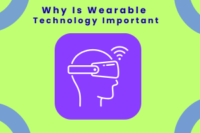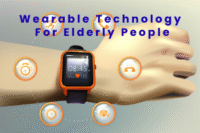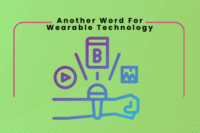What Is Wearable Technology and How Is It Changing Our Lives?
Published: 02 Feb 2025
What is wearable technology? It is one of the fastest-growing trends in today’s digital world. More than millions of people now use smart devices like watches, glasses, and fitness bands. These gadgets are not just for style. They track health, improve fitness, and even help with safety.
From checking your heart rate to showing maps on your wrist, wearable technology is changing daily life. It connects easily with phones and other devices, making it simple to stay updated and informed. This growth shows how technology is moving closer to people than ever before.
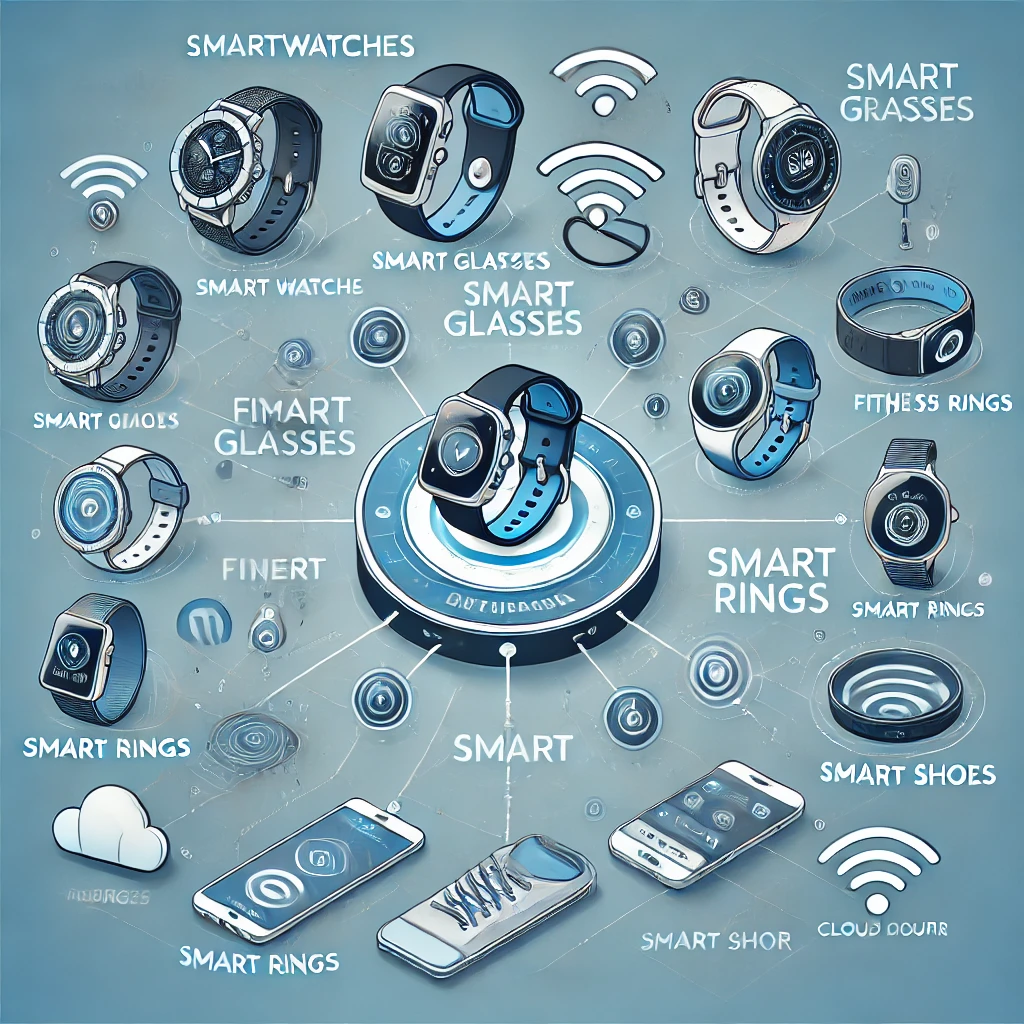
The global market for wearable technology is expected to surpass $150 billion by 2026, showcasing its growing impact. From smartwatches to fitness trackers, these gadgets are designed to improve health, productivity, and convenience. This wearable technology overview highlights how these devices are transforming the way we interact with technology and manage our daily lives.
Importance of wearable technology
Why is wearable technology important? Wearable technology is important because it helps people stay healthy, safe, and connected. It makes daily life easier by tracking health, saving time, and improving communication.
- Offers real-time health data, helping users manage fitness and wellness.
- Tracks daily activities, sleep patterns, and even stress levels.
- Enhances productivity by providing quick access to notifications and reminders.
- Improves convenience with features like hands-free calling and smart assistants.
- Helps with navigation and location tracking, especially with wearable GPS devices.
- Supports personal security with emergency alerts and location sharing.
- Offers entertainment through music and podcasts directly from wearable devices.
Why is wearable technology important today, and how will it impact the future?
When talking about wearable technology, it’s clear that it plays a vital role in making life smarter and easier. It helps track health, boost fitness, and keep people connected. Devices like smartwatches and fitness trackers are now everyday essentials.
The future of wearable technology will bring exciting changes to healthcare, education, and entertainment. Wearable technology future trends promise better health monitoring, more engaging learning experiences, and smoother daily routines, making the world more efficient and connected. For a deeper look into the future of wearables, you can check out Wearable Technology Explained by Investopedia, which provides useful insights into how these devices are shaping our daily lives.
The Importance of Wearable Technology for Students
The importance of wearable technology is clear for students. It supports learning by giving study reminders and tracking focus. It also helps them stay healthy by monitoring sleep, fitness, and daily activity.
- Better Learning: Smartwatches and fitness bands can remind students of class times and study schedules.
- Health Tracking: These devices track sleep and exercise, helping students stay active and rested.
- Easy Access: Students can quickly check messages or alerts without using a phone.
- Focus on Studies: Some wearables help block distractions during study time.
Wearable technology makes life simpler for students and helps them manage time and health better.
The Importance of Wearable Technology for Professionals
Understanding how wearable technology works can help professionals work better and stay healthy.It provides smart tools that make daily tasks easier.
- Time Management: Smartwatches remind professionals about meetings and deadlines.
- Health Monitoring: Wearables track steps, heart rate, and stress, helping professionals stay fit.
- Quick Communication: Notifications on wearables let professionals respond to calls or messages fast.
- Focus and Productivity: Some wearables block distractions to help with focused work.
Wearable technology supports professionals in staying organized, healthy, and efficient at work.
The Importance of Wearable Technology for Parents
Wearable technology for health and safety makes life easier for busy parents. It helps them stay healthy and connected while managing their family.
- Health Tracking: Devices monitor parents’ heart rate, steps, and sleep to ensure they stay healthy.
- Child Safety: Wearables like GPS trackers help parents keep track of their kids’ location.
- Time Management: Smartwatches remind parents of tasks, like picking up kids or attending school events.
- Stress Monitoring: Some wearables check stress levels and suggest ways to relax.
Wearable technology supports parents in caring for themselves and their families better
How Does Wearable Technology Work?
Wearable technology works by collecting, analyzing, and sharing data to help users monitor their health or activities.
Components:
Wearable technology uses small sensors, processors, and batteries to work. Sensors collect data like steps, heart rate, or temperature. A processor analyzes this data, and the battery powers the device. Many devices also use wireless connections, like Bluetooth, to share data with a phone or app.
Working:
When you wear the device, sensors start collecting data from your body or surroundings. For example, a smartwatch tracks your steps as you walk. The processor turns this data into useful information, like calories burned. The device then shows the results on a screen or sends them to your phone for easy viewing.
Wearable technology helps in many areas, but it’s not perfect. It’s important to understand what it can and can’t do.
- It only tracks fitness: Many think wearables are only for workouts. But they also track sleep, stress, and even medical conditions like diabetes.
- It’s not accurate: Wearables provide good estimates, but they are not as precise as medical devices.
- It’s hard to use: Most devices are simple to set up and use, with clear apps and instructions.
- It invades privacy: Wearables collect data, but most brands focus on keeping your information safe.
Types of Wearable Technology and Their Best Uses
Here are different types of wearable technology and their uses shortly:
1. Smartwatches
- Best for: Busy professionals and tech lovers who need notifications and fitness tracking on the go.
2. Fitness Trackers
- Best for: Fitness enthusiasts and beginners who want to monitor steps, calories, and heart rates.
3. Smart Glasses
- Best for: Tech-savvy users or gamers who enjoy augmented reality and hands-free information.
4. Wearable Medical Devices
- Best for: People managing health conditions, like diabetes or heart problems, needing accurate tracking.
5. Smart Clothing
- Best for: Athletes or fitness pros who want to track body performance through their outfits.
6. Wearable Cameras
- Best for: Travel bloggers, adventurers, or anyone needing hands-free photo or video capture.
7. Hearing Aids
- Best for: Individuals with hearing issues seeking improved sound quality and smart features.
8. Virtual Reality (VR) Headsets
- Best for: Gamers and learners who want to explore 3D worlds or virtual experiences.
9. Head-Mounted Displays
- Best for: Movie lovers and professionals needing portable displays for entertainment or work.
10. Smart Rings
- Best for: Minimalists who prefer compact fitness tracking or device control.
Each type serves a unique purpose, making it easier for users to pick what suits their lifestyle best!
Applications or Uses of Wearable Technology
In many areas, uses of wearable technology are making life easier and smarter. It helps people stay healthy, connected, and more efficient in their daily activities.
Wearable technology continues to grow, offering more ways to simplify and improve daily life!
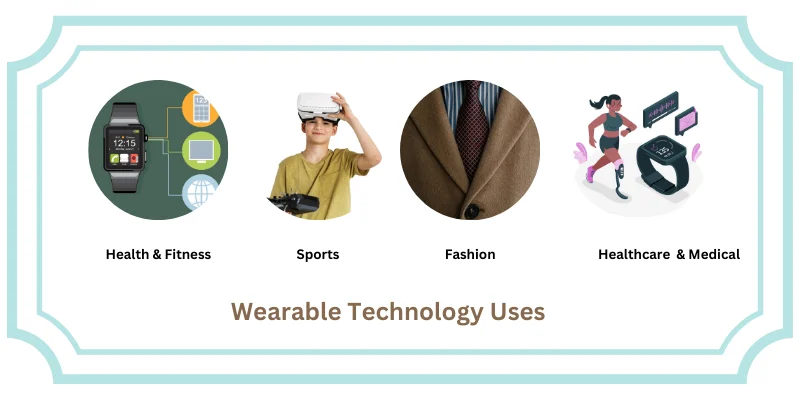
Now we will discuss uses or applications of wearable technology in healthcare, business and education as given below:
Applications of Wearable Technology in Healthcare
The rise of wearable devices used in healthcare is transforming health monitoring and personalized care in real-time.
Here are some key applications.
- Heart Rate Monitoring
- Wearables like smartwatches track heart rate continuously.
- Example: Devices like the Apple Watch alert users if their heart rate is too high or low.
- Fitness Tracking
- Wearables measure steps, calories burned, and physical activity.
- Example: Fitbit tracks daily activity to help users stay active and healthy.
- Sleep Monitoring
- Wearables track sleep patterns, helping users improve their sleep quality.
- Example: Devices like Oura Ring measure sleep stages and offer tips for better rest.
- Blood Oxygen Levels (SpO2)
- Devices measure blood oxygen saturation, helping detect respiratory issues.
- Example: The Fitbit Charge 5 offers SpO2 tracking to monitor lung health.
- Chronic Disease Management
- Wearables help manage chronic conditions like diabetes by monitoring blood glucose.
- Example: Continuous glucose monitors (CGMs) track glucose levels in real-time.
- ECG Monitoring
- Wearables can detect abnormal heart rhythms, offering early signs of heart conditions.
- Example: The KardiaMobile device records an ECG to check for signs of atrial fibrillation.
- Stress Tracking
- Wearables track stress levels by measuring skin temperature, heart rate, and more.
- Example: The Garmin Vivosmart 4 tracks stress levels through heart rate variability.
- Medication Reminders
- Wearables remind users to take their medication at the right time.
- Example: Some smartwatches can send notifications for medication schedules.
- Fall Detection
- Wearables can detect falls and alert emergency contacts or services.
- Example: The Apple Watch can detect falls and send an emergency alert if needed.
- Post-Surgery Recovery
- Wearables help monitor recovery after surgery by tracking vital signs and activity levels.
- Example: Devices like the Whoop band track recovery and provide insights into fitness levels.
These applications help users manage their health more effectively, improve quality of life, and assist healthcare professionals with remote monitoring and early interventions.
Applications of Wearable Technology in Business
The impact of wearable technology used in business is transforming operations by enhancing efficiency, employee well-being, and customer engagement. Here are some key applications.
- Employee Health and Wellness
- Wearables track employee health metrics, helping companies promote well-being.
- Example: Companies use smartwatches to monitor activity levels and provide wellness incentives.
- Productivity Tracking
- Wearables can monitor work patterns and productivity, ensuring efficient workflows.
- Example: Smart glasses can track time spent on tasks and assist in workflow management.
- Safety Monitoring
- Wearables improve worker safety, especially in high-risk environments like construction or manufacturing.
- Example: Wearable safety devices can monitor vitals and alert supervisors if a worker is at risk.
- Remote Work Support
- Wearables enable better communication and collaboration for remote workers.
- Example: Smart glasses or headsets help remote employees stay connected with real-time information.
- Customer Engagement
- Wearables enhance customer experience by offering personalized services or promotions.
- Example: Retailers use smartwatches to send special offers or loyalty rewards to customers.
- Data Collection and Analytics
- Wearables gather valuable data that businesses can use for market analysis and decision-making.
- Example: Fitness trackers collect customer behavior data, which businesses can analyze for insights.
- Employee Training and Development
- Wearable devices can provide hands-on, immersive training experiences.
- Example: Augmented reality (AR) glasses help employees learn new skills through guided instructions.
- Inventory Management
- Wearables help businesses track inventory in real time, improving supply chain management.
- Example: Smartwatches or AR glasses can help warehouse workers locate and manage stock.
- Enhanced Customer Service
- Wearables improve customer service by enabling staff to access real-time information.
- Example: Smartwatches help retail employees quickly check product availability and provide instant assistance.
- Enhanced Team Collaboration
- Wearables allow for seamless communication and coordination among team members.
- Example: Smart headsets enable hands-free communication, boosting teamwork in busy environments.
These applications make businesses more efficient, safe, and customer-centric, while enhancing employee satisfaction and overall productivity.
Applications of Wearable Technology in Education
The use of wearable technology in education is revolutionizing learning experiences, improving engagement, and supporting teachers. Here are some key applications.
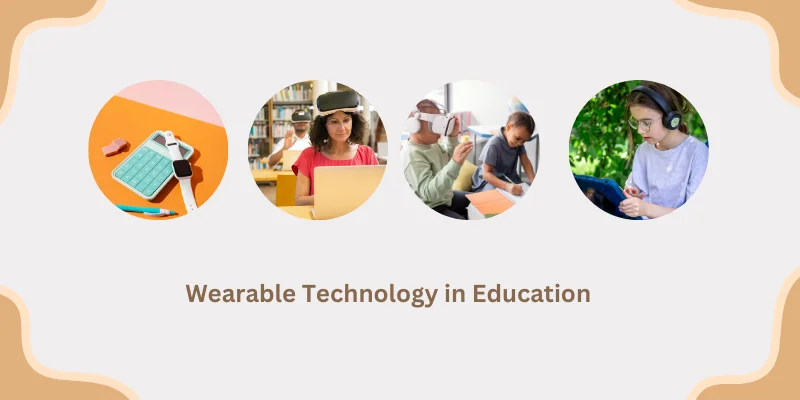
- Interactive Learning
- Wearables enable immersive learning experiences through virtual or augmented reality.
- Example: AR glasses help students explore historical sites or conduct virtual science experiments.
- Health Monitoring for Students
- Wearables track students’ physical activity, sleep patterns, and overall health.
- Example: Fitness trackers encourage students to stay active during school hours.
- Personalized Learning
- Wearables can adapt learning content to individual students based on real-time data.
- Example: Devices can adjust difficulty levels for exercises based on student progress.
- Attendance Tracking
- Wearables automate attendance by recognizing students’ presence in class.
- Example: Smart ID cards or wristbands register attendance without manual input.
- Remote Learning Support
- Wearables enable remote students to stay connected and engage in lessons.
- Example: Smart glasses or headsets allow for real-time communication and learning.
- Learning Disabilities Assistance
- Wearables help students with disabilities by providing real-time support and adjustments.
- Example: Wearable devices provide haptic feedback to help students with visual impairments navigate classrooms.
- Teacher Assistance
- Wearables can help teachers manage classrooms and track student performance.
- Example: Smartwatches allow teachers to track student activity and respond quickly to needs.
- Physical Education Tracking
- Wearables track students’ physical activity, heart rates, and fitness levels.
- Example: Fitness trackers monitor students’ progress during physical education classes.
- Field Trip and Campus Navigation
- Wearables assist students in navigating school campuses or during field trips.
- Example: GPS-enabled devices guide students through large campuses or outdoor educational trips.
- Real-Time Feedback for Students
- Wearables provide instant feedback to students, helping them improve.
- Example: Wearable tech can offer notifications or alerts if students are struggling with a task.
These applications help create a more interactive, personalized, and inclusive learning environment, benefiting both students and educators.
Advantages and Disadvantages of Wearable Technology
Many people want to know “ what is the pros and cons of wearable technology?”
Wearable technology offers numerous benefits, including enhanced convenience and real-time data monitoring. However, there are some negative effects of wearable technology, such as privacy concerns and potential discomfort.
Advantages
Here are some some wearable technology pros:
- Convenient health and fitness tracking
- Hands-free communication and notifications
- Real-time data for better decision-making
- Improved employee productivity and safety
- Enhanced customer engagement in retail
- Personalized learning experiences in education
Disadvantages
Here is a list of wearable technology disadvantages:
- Short battery life requiring frequent charging
- Privacy concerns with personal data collection
- Potential for skin irritation or discomfort from extended wear
- High cost of devices and accessories
- Limited functionality compared to smartphones
- Connectivity issues or syncing problems
If you want to study in detail, use the link advantages and disadvantages of wearable technology.
FAQ: What Is Wearable Technology
Wearable health technology refers to devices worn on the body that track and monitor health-related data. These devices can measure things like heart rate, steps, sleep patterns, and even blood pressure, helping users stay aware of their health in real time.
Examples of wearable technology include smartwatches, fitness trackers, and smart glasses. These devices help track health, fitness, and even provide notifications or other useful information right on your wrist or face.
The first wearable technology was the “pedometer” invented in the 1960s. It was a simple device that counted steps, helping people track their physical activity. Later, more advanced wearables, like smartwatches and fitness trackers, built upon this concept.
Wearable technology refers to electronic devices that can be worn on the body, like smartwatches or fitness trackers. These devices often track data such as health metrics, activity levels, or provide notifications, making life easier and more connected.
The purpose of wearable technology is to help users monitor their health, stay connected, and improve daily activities. These devices track data such as steps, heart rate, and sleep patterns, offering insights that can lead to healthier and more efficient lifestyles.
Yes, wearables are generally safe to use, but some people may experience skin irritation or discomfort. It’s a good idea to clean your device regularly and make sure it fits comfortably. Always check the manufacturer’s guidelines for safety and usage instructions.
Wearable technology is important because it helps people monitor their health, stay connected, and improve their daily routines. It makes it easier to track fitness, manage tasks, and get real-time updates.
Wearable technology started with simple devices like pedometers in the 1960s. These early gadgets tracked steps, and over time, technology evolved into more advanced devices like smartwatches and fitness trackers
Wearable technology can affect your privacy by collecting personal data like your location, health metrics, and activity. If this data isn’t secure, it could be accessed or misused by others. It’s important to use devices with strong privacy protections.
For beginners, fitness trackers like Fitbit or the Apple Watch are great options. They offer easy-to-use features, like step counting, heart rate monitoring, and basic notifications. These devices are perfect for anyone starting to explore wearable technology.
Conclusion
Wearable technology refers to smart devices that people wear on their body, like smartwatches, fitness trackers, smart glasses, and even smart clothing. These devices track health, fitness, and daily activities while also connecting with phones and other gadgets. Knowing the different types of wearable technology is important because it helps people choose the right device for their needs—whether for studying, fitness, work, or entertainment. Understanding these types also shows how wearables are changing daily life by making tasks easier, healthier, and smarter.
Wearable technology is more than just a trend—it’s a smart way to make life easier, healthier, and more connected. From tracking your fitness goals to helping with studies or even making daily tasks simpler, these devices are designed to fit different lifestyles. If you haven’t explored them yet, now is the time. Take a look at the different types of wearable technology and choose the one that matches your needs best. The right device can be a small step that makes a big difference in your everyday life.

- Be Respectful
- Stay Relevant
- Stay Positive
- True Feedback
- Encourage Discussion
- Avoid Spamming
- No Fake News
- Don't Copy-Paste
- No Personal Attacks

- Be Respectful
- Stay Relevant
- Stay Positive
- True Feedback
- Encourage Discussion
- Avoid Spamming
- No Fake News
- Don't Copy-Paste
- No Personal Attacks
